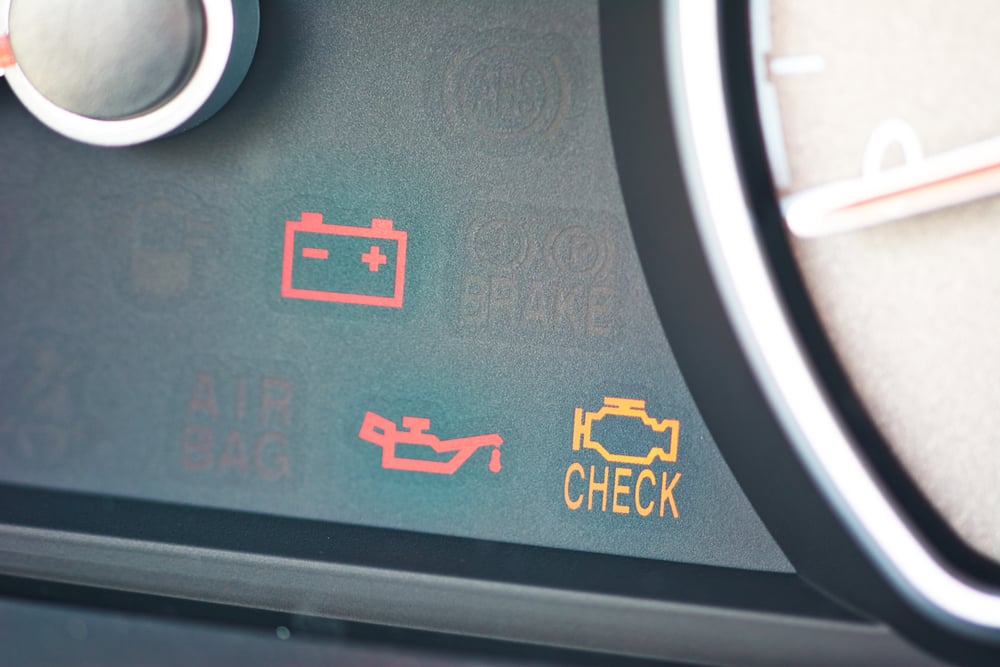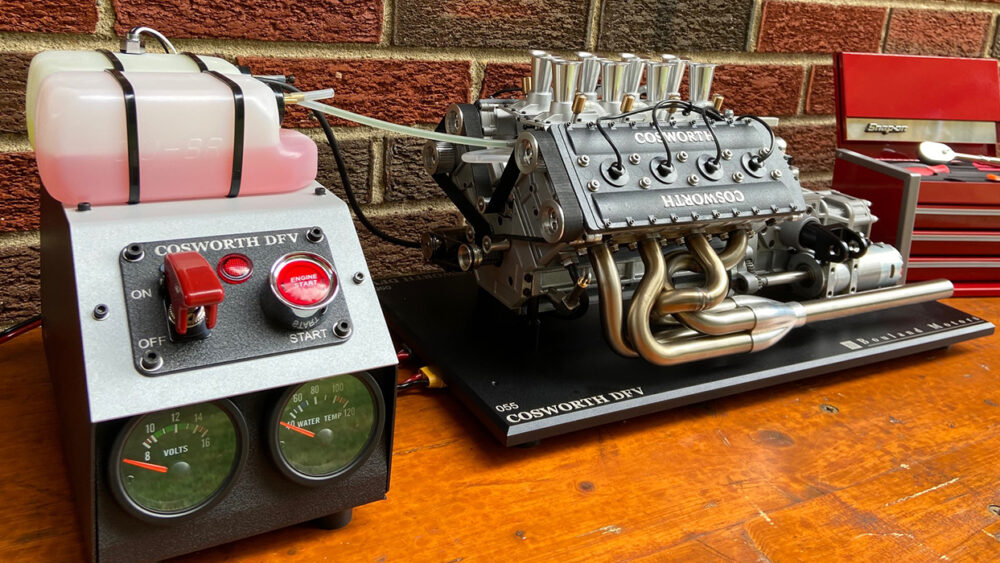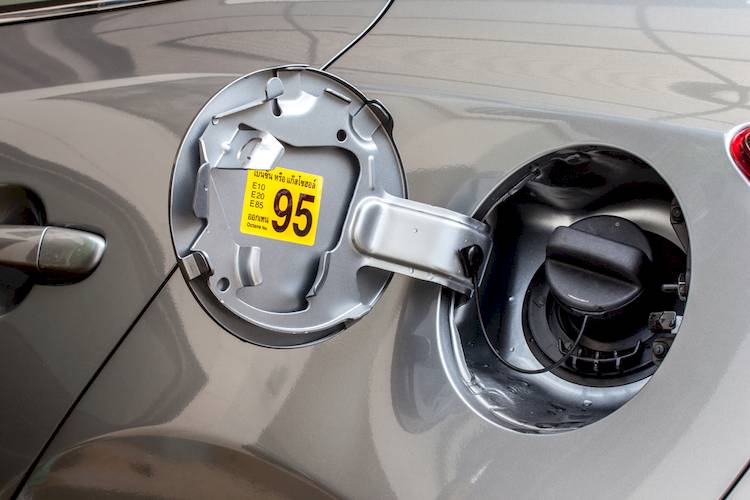Problems occur when your fuel tank is overfilled and/or gas flows into the EVAP line. A defective refuel and/or fuel cutoff valve prevents fuel from flowing and the refuel valve triggers the gas pump to stop, causing the car to stall. Brought to you by Leaf Group. Unclog or replace gas cap if air vent is blocked. Change air filter if it’s clogged or dirty. Prime engine if equipped with small rubber bulb. Replace fouled or dirty spark plug. This is because a rich fuel mixture is over-saturated with gas, causing ignition problems. Mixtures that have too much air and not enough fuel are lean and tend to reduce the amount of power available under load and can cause stalling. In both cases, a professional carburetor inspection and adjustment are necessary to correct the problem. If so, a simple gas cap replacement may be able to solve your problem. It is a good idea to inspect the seal that is between the gas cap and the filler tube for any tears or cracking that could cause a vapor leak.If you are satisfied that the gas cap is.
OK here is a quiz for you 4runner geniuses. I need your help to save my baby-2000 4runner SR5.
This problem has been going on for a while, it comes and goes. The truck will start stalling out, sputtering along, then pick right back up. It is like the engine is being choked for gas. It never totally fails, I just lose all engine power for a second or two, then it picks back up. Then, the check engine light will turn on.
I thought the light might be for a gas cap, so I checked that first. Unscrewed the gap and hear a very noticeable “whoosh” air noise, like air getting sucked into the gas tank. After I adjusted the gas cap, the truck starts working as normal, runs great. For a couple weeks or so. Then the same problem. And the same fix has always worked as well - the gas cap trick, thus far, has worked every time (about five times).
I took it to a mechanic and they said the codes are for the throttle and I need a new throttle body for $1500 freakin dollars. I don’t doubt the throttle could probably use replacin, but I don’t think that’s is what is causing this issue. If the throttle was the problem, it doesn’t seem like it would be a problem that comes and goes. And why does the gas cap fix work?
Things I have replaced in the few years - fuel filter about a year ago, air filter recently, evap, O2, cat, timing belt, water pump, gas cap (about a month ago). Needless to say, I got a lot of $ into it. Think it could be fuel pump?

Really weird, me and my friends are stumped. I will probably try another mechanic and see what they say.
The gas cap’s purpose is to provide a reliable cover that stops dust, debris, and dirt from entering the gas tank. It plays a significant role in converting dangerous fuel vapor into harmless discharge in the car’s emissions system. Because you have to remove and replace your vehicle’s gas cap for every refueling session, the cap eventually wears out, and you may need to replace t after some time. Loose gas caps can lead to fuel leakage problems that bring about uncomfortable smells and worse hazardous risks to you and your car.
What are the symptoms of a bad gas cap? Here is a detailed list of problems associated with a failing gas cap.
Symptoms of Bad Gas Cap
Because a faulty gas cap can lead to several mechanical problems, it is essential that you watch out for the following symptoms that mean you need to get a cap replacement.

Problems Tightening the Cap
The first and most apparent symptom of a failing gas cap is it develops tightening and fitting problems. Vehicle manufacturers design gas caps in such a way that they click once to let you know they correctly tightened. A damage cap cannot tighten until it makes a clicking sound. On occasion, the gas cap pops open even after tightening it.
These simple signs show you that it is high time you replace your gas cap.
Strange coloration at around your gas tank mouth
When you have strange discoloration or coloration around your gas tank door cover, you probably are dealing with a failing gas cap. Since the gas cap cannot seal the tank adequately, fuel fumes escape and deposit on the gas tank opening. These fumes progressively discolor the surfaces they come across. Therefore, you can easily diagnose a leaking gas cap by the deposited fuel residue inside your filler door gas tank cover.
Foul Gasoline Smell While Driving
Since your vehicle leaks fuel because your gas cap cannot seal the tank, you can expect to experience a foul fuel smell every time you are in the car. The escaping vapor not only makes your vehicle uncomfortable to use but is a severe health risk. Furthermore, petroleum is highly volatile and can ignite when triggered by any fire source.
Can A Bad Gas Cap Cause Stalling
Poor Fuel Economy
Apart from keeping the environment cleaner by protecting it from fuel fumes, the gas cap also saves you a lot of money by making the car fuel-efficient. A leaking or broken gas cap affects your fuel economy, crucially causing low mileage. If you don’t replace it, you can waste as much as 30 gallons of fuel within a year. If that is not enough, the leaking fumes cause worse greenhouse problems to the environment.
The Check Engine Light Comes On
Another symptom of a failing gas cap is the illumination of the check engine light. Since the gas cap is an essential part of the car’s emissions system, it can worsen the system’s efficiency if it has inadequate gas sealing. A gas cap that cannot seal can cause an EVAP system leak. The EVAP leak sets off the Check Engine Light.
Although a bad gas cap cannot cause loss of power and critical performance issues, it sets off the Check Engine Light. An illuminated check engine light will cause the car to fail an emissions test. Therefore, you need to take the car to the mechanics for inspection or purchase and replace the filler cap whenever you suspect it is malfunctioning.
You May Like:How to Dispose of Old Gasoline [Step by Step Guide]
Symptoms of a Bad Gas Cap (FAQs)
Q: Can a Bad Gas Cap Cause Idle Problems?
Almost all fuel injected cars use pressurized fuel systems and depend on the gas cap to be tight enough to deliver the required pressure. Therefore, a loose or a failing gas cap will bring about idling problems because of insufficient fuel system pressure.
You can also have a rough idle from dirt and impurities that make their way into the gas tank’s neck because the gas cap cannot shut off correctly. These impurities alter the fuel injection pressure and clog or block the featured fuel delivery and cause rough idling.
Q: Can a Bad Gas Cap Cause Misfire?
A car misfires when the required fuel combustion does not occur. Insufficient combustion happens when your air to fuel ratio is not at the required levels. Damaged gas caps leak fuel outside the tank and pipes. They also allow impurities into the vehicle fuel system. However, they only affect the fuel-to-air ratio slightly.
Therefore, can a bad gas cap cause stalling and misfires? It can, but the most likely causes for vehicle misfires would be a malfunctioning air flow sensor, a bad fuel pump, spark plugs, and ignition problems, or electrical transmission issues.
Make sure you watch out for symptoms of these parts malfunctioning before you head to the repair shop to buy a new gas cap.
Q: Does a Bad Gas Cap Affect Mileage?
As mentioned earlier, one of the worst effects of driving with a faulty or absent gas cap is that you will lose a lot of fuel through spillage and gaseous emission. Your vehicle will be subject to poor fuel economic efficiency, which will lower the distance you can drive with a gallon of gas.
Using a vehicle with terrible mileage is not only financially uneconomical but puts you at the risk of abruptly getting stranded with an empty tank on the highway.
Q: What Codes Will a Bad Gas Cap Cause?

Several engine problems can set off the check engine light. However, when your car has a failing gas cap, it sets out a P0455 or a P0457 code to the car’s ECM. The codes mean that your vehicle has a massive leak or a loose gas cap problem.
The codes can also represent insufficient pressure in the fuel injection system due to the faulty gas cap.
Q: How Can I Test my Gas Cap?
Although most gas caps are attached to their car’s fuel cap door, there are times people forget to close their gas caps after they refueled their vehicles. When you drive the car from the gas station, the check engine light automatically comes on. Other car models fail to restart or run with difficulties. The check engine light indicates that the gas cap is missing, not sealed, or damaged.
How to fix a loose gas cap is a simple procedure. Open the fuel tank door by pushing a button in your glove compartment box or next to the seat. Physically open the tank door and check the cap carefully for physical damages. When there aren’t any damages, screw the gas cap to the tank and make sure it clicks to symbolize that it’s completely tightened.
Q: How Long Do Gas Caps Last?
Depending on your car model, the environmental conditions it is subjected to, and how well you take care of it, the gas cap can last you a mileage of more than 50,000 miles. However, since you screw and unscrew the caps frequently whenever you refuel, the filler caps require replacement after a while to avoid the previously mentioned problems.
Most small car parts’ lifespans are influenced by the salinity, temperature, and humidity of the vehicle’s environment.
Q: How To Check for Bad Gas Cap Leaks
Does A Bad Gas Cap Cause Stallings

Modern car’s Evaporation Emission Control Systems automatically run tests to detect gasoline vapor leakages from the EVAP and the gas tank system. The EVAP tests are responsible for the P0455 and P0457 codes sent to the computer to notify you of leaking gas.

However, these tests only run at specific times. They don’t run diagnostics when the fuel tank is less than 15% full or when it’s more than 85% full. Also, the self-test doesn’t run when there extremely cold or hot temperatures. Therefore, the vehicle will most likely run EVAP tests a long time after you parked your car.
If you received a bad gas cap code and closely inspect your gas cap, but you don’t find physical evidence of the leakages, it may mean your leakages are at the vapor HOSES. Start with asking yourself, how can I test gas cap pressure? You can use pressure testing to rule out leakages in deeper parts of the fuel system. Use needle and nose vise grips to seal the supply and outlets of the tank. Use a pressure tester to find out if there are any pressure changes after five minutes of clamping the reservoir’s inlet and outlet.
Alternatively, you can confirm leaks by using a smoke machine with low-pressure oil with colored dye. Pumping the EVAP system with this colored oil will help you identify the location of the leakages.
Read Also:10 Best Fuel Line Materials Reviews
Do I Need to Replace My Gas Cap? YouTube
Final Words
Can Bad Gas Cap Cause Stalling
Apart from providing a top to the fuel tank, a vehicle gas cap performs many operations to ensure a car runs smoothly. A fuel cap maintains the fuel system vacuum pressure seal allowing the pump to feed fuel to the combustion system efficiently.
Can A Bad Gas Cap Cause A Car To Stall
A fuel cap also seals deadly pollutants and fumes in the tank and protects the environment. The EVAP processes protect vehicle passengers and the environment from the negative effects of gasoline fumes.
Finally, the gas cap protects the gas tank contents from external impurities, dirt, and water during rainy weather. When you don’t have a clean gas tank because of debris or impurities, your vehicle will experience clogging, which spoils injection systems, the fuel filter, and the pump tank. These problems cause engine malfunction and diving difficulties.